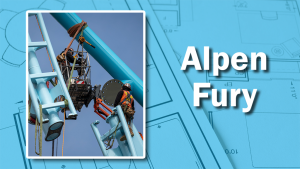When you need to get a fleet of rock trucks to Fort McMurray, Alta. you don’t drive ’em, you ship ’em. Specializing in transporting some of the heaviest, longest and widest loads is Richards Transport Ltd. of Regina, Sask.
The company was founded in 1954 by Lorne Richards on the back of a 1951 Ford 800 fifth wheel power unit pulling a steel tanker semi trailer.
"We expanded and diversified through the early 1990s," says Boyd Richards, vice-president of human resources and special projects and part of the second-generation management team that includes brothers Darcy and Russ. "The company then took a hard look at itself and refocused on the niche of what it did best — moving loads that other transport companies couldn’t or wouldn’t."
Today, the company employs almost 100 and is allied with 500 sub-contractors across the U.S. and Canada. Richards’s yard is home to 30 transport trucks and 100 specialty trailers, including such specialized units as wind turbine component trailers. The single longest trailer measures 220 feet.
Currently, the company is hauling a fleet of refurbished CAT 777 rock trucks from a customer’s yard in Edmonton to the Regina Bypass highway project.
"Each of them is about 20 feet wide and 19 feet tall," says Richards. "We’ve delivered three so far and we’re delivering a dozen in total."
Rock truck deliveries can also go for the long haul. A recent contract saw the massive vehicles broken down into components in Nevada, then delivered to Fort Mackay, Alta., an hour north of Fort McMurray, where they were reassembled.
A recent routine "big job" involved transporting 18 loads of girder assemblies from Winnipeg to a highway overpass project in Fort McMurray. Each assembly measured more than 120 feet long and weighed more than 100,000 pounds.
Some of the loads are delivered even farther north.
"We deliver to Lake Athabasca, Stony Rapids and Black Lake, north of Prince Albert, Sask.," says Richards. "The final section of that trip is over ice roads, whenever they’re open — although this has been a terrible winter for ice roads."
Richards’s heaviest loads exceed 250,000 pounds. A recent scale tipper was a 210,000-lb. rail bridge structure for a railway overpass transported in the summer of 2015. The tallest loads (35 feet) as well as some of the widest (42 feet) were massive steel components delivered to the Boundary Dam Integrated Carbon Capture and Storage Demonstration project in Estevan, Sask.
"Delivering the huge components of wind turbines has become a specialty for us," says Richards. "The turbine blades are some of our longest loads at up to 165 feet."
Because the turbine blades are rigid and structurally strong, the loads aren’t carried on a trailer. The blade itself becomes the trailer.
"We use a steer dolly with a turntable to support the back of the load," says Richards. "We weld in stoppers and chain the load down to the steer dolly. We have two modes for the dolly. In autoturn, the dolly is highly controlled by the movement of the truck, so if you turn right or left it turns along with the truck.
"When you get to the delivery site and disconnect the auto assembly you have to be a little more creative. You need a rear flag person who has a hand-held remote control and voice connection with the driver.
"Together they manoeuvre the load into its final position. Drivers who can handle these loads require a high level of certification and it can take a while for them to take on autoturn tasks."
Richards notes the company still hasn’t met its match for heavy hauling on behalf of clients.
"If we don’t have the equipment to haul your load, we’ll either find it or build the equipment ourselves," he says.











Recent Comments
comments for this post are closed